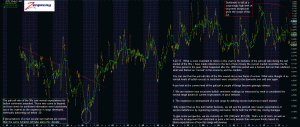REDEFINING EXPECTATIONS FOR THE PUT/CALL RATIO DURING SECULAR BULL MARKETS
Let's begin this post with what I think is an obvious presumption: We are currently in a bull market that is secular in nature. I base this presumption on a number of factors, most important is the simple fact that numerous important indices are posting consistent all-time highs. Without getting into the technical particulars (these are easy to find if you spend 20 minutes on this site), all-time highs in leading indices following an extended period of crisis, doubt and under-performance can generally be trusted to signify a bull market that is much more than cyclical in nature.
If we accept this presumption, then we must also accept the fact of what a secular bull market entails at its core: An expansion of ranges for all available metrics. This is regardless of whether these metrics are technical or fundamental in nature. In other words, price/earning ratios form an expansive new range. Markets caps that were previously thought of as absurd become the new normal. Technical measurements of excess are rethought and reformed. The very nature of a bull market is rethinking what are acceptable measures of prosperity. With each new secular bull market this rethinking process has occurred, which eventually has led to instability due to the paradigm shift that takes the economy into places where protective legislative and corporate measures fail. We are far from this point, but the reason it is worth mentioning is to aide in conceptualizing how dramatic the shift in the pricing landscape (ranges in price) must be that it challenges the very structure of economy.
Let's now use the aforementioned presumption in paragraph one and fact in paragraph two to look at a favorite measure for gauging sentiment. The put/call ratio is one of the most valuable tools to measure sentiment. There is one consideration, however, that investors fail to make during bull markets. The absence of this consideration creates false signals galore that dissuades investors from considering the put/call ratio as a bull market matures. The consideration is the fact that just as multiples, market caps and technical indicators will face an expansion in what is seen as normal ranges, so will the put/call ratio.
This means that the measurement previously considered to be golden at picking tops for a bull run, will fail consistently as a market matures. As a bull market expands, so should an investors expectations of what is considered "extreme bullish sentiment."
Let's look at a long-term chart of the combined put/call ratio using 20 & 100 day moving averages only, looking all the way back to 1995-present:
click chart to enlarge


